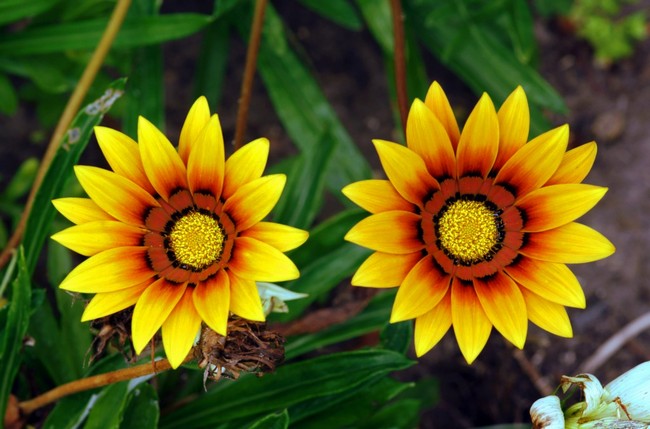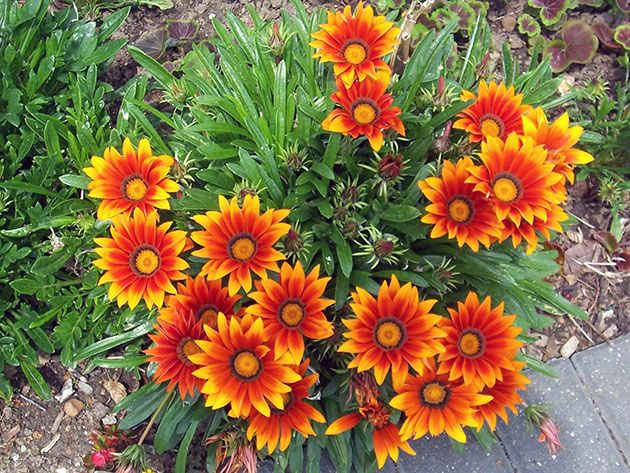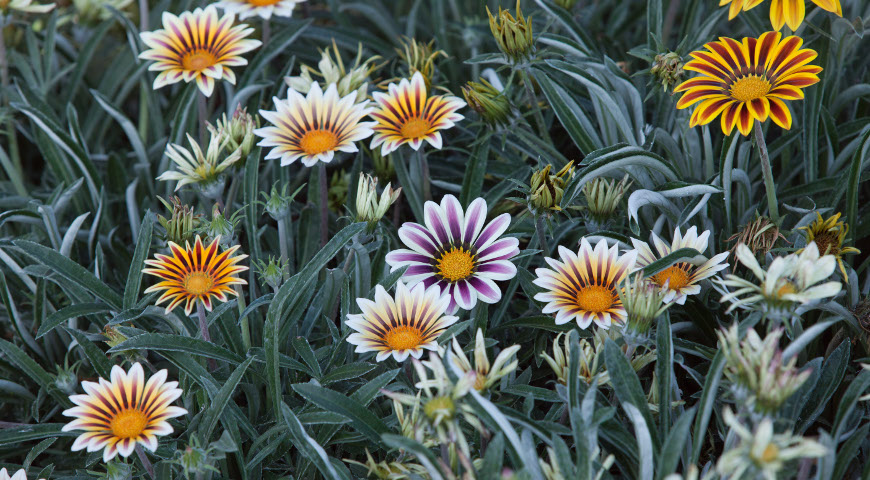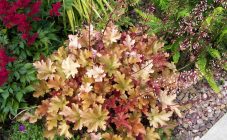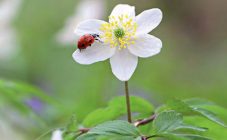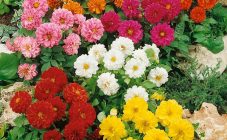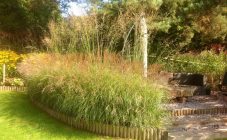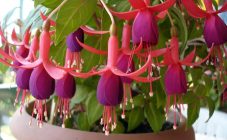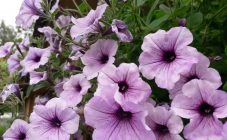Content:
Gatsania, gazania or African chamomile is the name of the same flower that belongs to the Aster family. Europeans learned about it in the 17th century and quickly fell in love, calling it the flower of the midday sun for its property to open its petals by this time of day. The plant was chosen by landscape designers and summer residents, using it in mixborders, flower beds, rabat beds.
Description
Gazania is a herbaceous bush up to 30 cm high, with dense leaves of a rich green or gray-green color. Depending on the variety, the shape of the leaf plates may be different. On their inner side there are villi that protect against drought and cold. Leaves and inflorescences are collected in a basal rosette.
Flower baskets are solitary, reach a diameter of 5 to 9 cm. During the period of active flowering of gassing, there can be up to 35 of them on the bush. Lingulate petals are yellow, orange, red with a brown spot at the base. The core of the flower bud consists of tiny, funnel-shaped tubules of bright yellow color.
After the flower buds have faded, fruits are tied in their place, which is a hairy achene with a tuft. Gazania flowers are grown outdoors and indoors. Many are interested in how to pronounce gazania or gatsaniya more correctly, to which one can answer: both options are true. Translated into some languages, the Latin name gazania sounds like gatsaniya (the letter z is pronounced as c).
Types and varieties
Breeders have bred many varieties and varieties of gazania, the most popular of which are listed below.
- Gatsania brilliant (harsh) - has petals from bright yellow to brown. Its buds quickly open at the beginning of daylight hours and quickly close at sunset.
- Long-rifle gazania got its name because of its highly elongated, narrow petals. Her coloring is mainly contrasting: dark orange - in the middle of the petal, yellow - along its edges.
- Hybrid. It includes hybrid varieties bred from gazania long-rifle and brilliant. Grown as an annual plant. Hybrid varieties are more resistant to adverse conditions. The most beautiful of them are: Chansonet gatsania - inflorescences have a whole mixture of colors; gatsaniya variety Talent - it has silvery leaves, its peculiarity is that the inflorescences do not close at sunset; gazania of the Big Kiss variety - has foliage with a beautiful glossy surface and flowers of various shades, reaching a size of 12 cm.
- Peacock. The plant has large inflorescences with yellow tubular petals and an orange core. Her leaves are green on top, silvery below.
In addition to those listed, there are the following varieties of gazania: linear, feathery, one-flowered.
Growing
You can get gazania on your site in 2 ways: by sowing with seeds or by rooting a stalk of an existing plant.
Seeds
The process of growing flowers at home begins at the end of winter. It consists of the following actions:
- A substrate is prepared from sod land, peat, sand.
- Drainage is poured into the box, then the prepared soil mixture.
- Seeds are spread over the surface in a checkerboard pattern, which are then covered with a thin layer of sand.
- Seedlings are lightly sprayed with water from a spray bottle.
- The box is covered with foil to create conditions under which the seeds hatch faster, and placed in a warm, bright room.
The first shoots will appear soon. When the seedlings release 3-4 leaves, they must be transplanted into separate containers. Before planting a young gazania on the site, it must be pre-hardened, taking it outside every day. In the southern regions, seeds can be sown directly into the ground in spring.
By cuttings
Propagation by cuttings is carried out in the summer, when the bush is full of strength. For this, strong, healthy shoots are selected, which are cut off with a sharp knife. There must be a heel on the handle, otherwise it will not take root. Rooting is done as follows:
- The stalk is freed from the lower leaves and placed in a container with water.
- When the roots hatch, each cutting is planted in a separate small pot.
- The plant is covered with a film for better survival.
- When the young gazania grows up and hardened, it is planted in open ground.
In the previously plowed land, holes are made of such a volume that a plant with a lump of earth can freely fit in them. The bushes are planted at a distance of 20 cm from each other in light, loose soil with a neutral reaction. The landing site should be well lit by the sun.
Application in design
Due to its variegated color and short stature, the gazania flower has gained great popularity among landscape designers and summer residents. It can be used to frame the edges of flower beds, plant along paths, create various patterns and shapes from it. It would be appropriate to place the gazania in rockeries among the stones.
The flower looks decorative from spring to autumn, so it can be used to decorate less expressive plants by planting in the foreground. In addition, gazania is grown in hanging baskets in combination with lobelias and pelargoniums, placing them on the terrace, veranda, loggia, balcony. The flower will look no less impressive in garden vases and pots in the local area.
Diseases and pests
Gazania is rarely affected by diseases, but it does happen sometimes. This is mainly due to improper care. Planting in a shady place combined with excessive soil moisture can lead to various types of rot.
As a control method, they completely get rid of the affected plants. With a slight infection, the rotten parts are cut off to healthy parts, then the bush is sprayed with antifungal drugs. The land on which gazania grows also needs to be disinfected.
The flower can be chosen by pests: slugs, snails, aphids, spider mites. To get rid of them, you need to carry out the following activities:
- snails are collected by hand, preventing their further spread;
- to get rid of slugs, the area between the bushes is covered with lime;
- insecticides are used against aphids and spider mites.
You can prevent the appearance of slugs by weeding the area, as well as avoiding excessive moisture.
Gatsania: annual or perennial
In the Russian climate, it is cultivated as an annual. If you want to make it a perennial crop, you will need to take care of its wintering. For this, perennial gazania is dug up in the fall and transplanted into a pot. Then it is transferred for storage in a bright, cool room (t - 8-10 ° C). Under these conditions, the bush will continue to develop. Watering during this time should be moderate. In winter, foliage can be trimmed by rooting and getting new plants. In the spring, the bush is planted in the garden. New shoots will quickly grow on it.
Growing gazania as an annual or perennial plant, the gardener acquires a spectacular, colorful green space on his site. It can grow alone, or it can be an addition to other decorative deciduous or decorative flowering plants.
